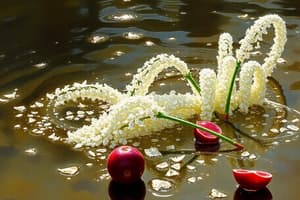Podcast
Questions and Answers
What is the problem that occurs when a free flowing powder transforms into lumps and eventually an agglomerated solid?
What is the problem that occurs when a free flowing powder transforms into lumps and eventually an agglomerated solid?
Caking
What is the general trend of reaction rate as water activity increases from the monolayer value?
What is the general trend of reaction rate as water activity increases from the monolayer value?
It increases
At what water activity is the minimum reaction rate of Lipid Oxidation?
At what water activity is the minimum reaction rate of Lipid Oxidation?
Around 0.3 aw
What is the water activity range where the maximum loss of amino nitrogen occurs in Maillard reactions?
What is the water activity range where the maximum loss of amino nitrogen occurs in Maillard reactions?
How can water activity be controlled to prevent moisture migration between components in a composite sample?
How can water activity be controlled to prevent moisture migration between components in a composite sample?
What is the primary role of humectants in controlling water activity?
What is the primary role of humectants in controlling water activity?
What is the relation between water activity and microbial growth?
What is the relation between water activity and microbial growth?
What is the role of water activity in determining the texture of a product?
What is the role of water activity in determining the texture of a product?
What type of reactions are affected by water activity in terms of chemical stability?
What type of reactions are affected by water activity in terms of chemical stability?
What is the application of water activity in preventing mold growth?
What is the application of water activity in preventing mold growth?
Flashcards are hidden until you start studying
Study Notes
Water Activity (Aw)
- Water content alone is not a reliable indicator of perishability.
- Aw is a measure of the intensity of water associated with non-aqueous constituents.
- Bound water is less able to support degradative activities like microbial growth or hydrolytic chemical reactions.
Definition of Water Activity
- Aw is an equilibrium property of water at a given temperature and moisture content.
- Aw = p/po, where p is the partial pressure of water vapor at the surface of the product, and po is the saturation pressure or the partial pressure of water vapor above pure water at the same temperature.
- Aw = RVP (relative vapor pressure) = ERH/100, where ERH is the equilibrium relative humidity.
Water Activity and Temperature
- Water activity is temperature-dependent.
- Temperature changes water activity due to changes in water binding, dissociation of water, solubility of solutes in water, or the state of the matrix.
- The effect of temperature on water activity is product-specific, with some products increasing water activity with increasing temperature, while others decrease aw with increasing temperature.
Moisture Content
- Moisture content is a quantitative measure of the amount of water in a product.
- Empirical measurement with no standard, with primary methods including loss on drying and titration.
Microbial Growth
- Water activity affects microbial growth, with aw values below 0.80 generally inhibiting microbial growth.
- Cheese and Cracker System experiment: aw values increased/decreased with moisture content changes.
Moisture Sorption Isotherm (MSI)
- MSI measures the change in free energy of water in a food material.
- Constructed using resorption (or adsorption) method, where a completely dry food material is incubated in controlled humidity chambers at constant temperature.
- MSI shapes and positions depend on the composition of the food material and phase states of the components.
Significance of MSI
- MSI relates to chemical and physical changes, microbial spoilage, and stability of foods.
- Change in the monolayer moisture content with temperature affects the stability of foods.
Classification of Water States in Foods
- Constitutional water: an integral part of non-aqueous constituents, experiencing phase changes and becoming hygroscopic (e.g., sorbitol and sucrose).
- Other water states: non-hygroscopic (e.g., mannitol), or coupled states in foods at different water content levels.
Powder Flow and Caking
- Caking is a water activity, time, and temperature-dependent process, affecting powder flow and stability.
- Water activity and food stability are closely related.
Chemical/Biochemical Stability
- Reaction rate increases as water activity increases from the monolayer value.
- Common reactions related to chemical stability include Maillard browning, lipid oxidation, hydrolysis, nutrient degradation, and enzymatic reactions.
Controlling Water Activity
- Methods include dehydration, edible films and coatings, and additives/ingredients involved in water binding (e.g., humectants, sugars, and salt).
- Water activity affects moisture migration, product formulation, microbial growth, texture, and chemical stability.
Studying That Suits You
Use AI to generate personalized quizzes and flashcards to suit your learning preferences.




